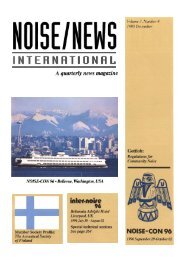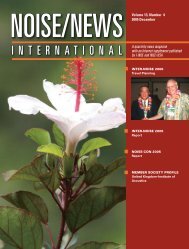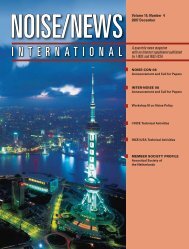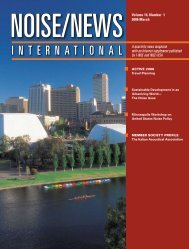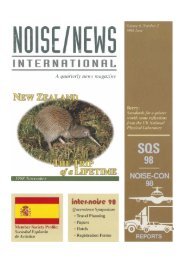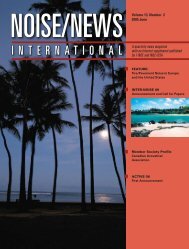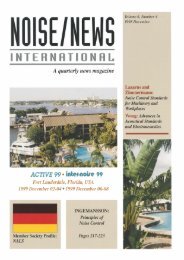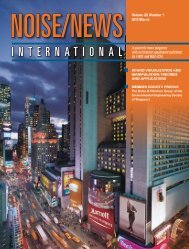Volume 14, Number 4, December, 2006 - Noise News International
Volume 14, Number 4, December, 2006 - Noise News International
Volume 14, Number 4, December, 2006 - Noise News International
You also want an ePaper? Increase the reach of your titles
YUMPU automatically turns print PDFs into web optimized ePapers that Google loves.
IEC—<strong>International</strong> Electrotechnical<br />
Commission<br />
IMMA—<strong>International</strong> Motorcycle<br />
Manufacturers Association<br />
IMO—<strong>International</strong> Maritime Organization<br />
ISO—<strong>International</strong> Organization for<br />
Standardization<br />
OICA—Organisation <strong>International</strong> des<br />
Constructeurs d’Automobiles<br />
SAE—SAE <strong>International</strong><br />
UNECE—United Nations Economic<br />
Organization for Europe<br />
WTO—World Trade Organization<br />
Customer-driven<br />
product noise and sound<br />
quality—a matter of<br />
competitiveness<br />
Juha Plunt - Ingemansson Technology<br />
AB - Gothenburg, Sweden<br />
Introduction<br />
The principal objective of product noise<br />
control is to reduce the noise emissions<br />
of products. Reductions are necessary to<br />
meet legal limits imposed by regulations,<br />
to provide the customer with a silent<br />
alternative, to increase the probability of<br />
survival for products used by the military,<br />
and to enable the manufacturer to mark the<br />
product as having a low noise level. The<br />
most common descriptor for product noise<br />
emission is the A-weighted sound level.<br />
These objectives are complementary to<br />
those of product sound quality improvement.<br />
These improvements make the sound<br />
produced by a product more pleasing to<br />
the user (the customer) and a part of the<br />
character of the brand of the product. The<br />
metrics for sound quality are more complex<br />
than the A-weighted sound level that does<br />
not necessarily have to be minimized.<br />
Legislation versus Customerdriven<br />
noise and sound<br />
quality targets<br />
Legislation-driven targets must be met<br />
in order to market the product. Political<br />
compromises setting the target levels may<br />
lead to slow progress. What is needed<br />
are simple target-setting metrics (e.g.<br />
L Aeq<br />
) and simple control methods. The<br />
targets should lead to “binary” product<br />
development (OK or not OK relative to<br />
the target limits). As far as customerdriven<br />
targets are concerned, there are<br />
no clearly-defined targets for a product<br />
to be competitive. In many respects,<br />
sound quality is a moving target as the<br />
quality attributes are quite complex.<br />
Sound quality plays a major role when<br />
“comfortable” noise levels have been<br />
achieved. Manufacturers have found that<br />
sounds and sound quality communicate<br />
total product quality and a pleasing<br />
subjective sound impression is important<br />
to retain a returning customer.<br />
An example illustrating how competition<br />
forces the manufacturers to produce quieter<br />
products is provided by floor-standing<br />
dishwashers. The Swedish Consumer<br />
Agency established a simple rating<br />
scale of 1 to 5 instead of dBA where 1<br />
corresponded to noise levels above 60<br />
dBA and 5 to noise levels below 45 dBA.<br />
Competition forced manufacturers to<br />
produce quieter dishwashers between 1970<br />
when the average for ten different brands<br />
was 1 on the rating scale and 1990 when<br />
the ratings dropped to 5 or better. When<br />
all brands reached a rating of 5, there were<br />
no further reductions after 1990; and after<br />
the 5-graded noise scale was discontinued<br />
we still have units between 5+ and 3. The<br />
declared noise levels today range between<br />
41 and 57 dBA.<br />
There are several lesson learned from<br />
the example of dishwashers. A simple<br />
quality scale (1 to 5) for noise performance<br />
is effective to drive noise levels down.<br />
Confusing or too precise metrics<br />
(logarithmic units such as the decibel)<br />
are not assimilated well by the customer<br />
and result in a lack of incentive for<br />
manufacturers to improve the product if cost<br />
is involved. The products available on the<br />
market will include noisy products sold by<br />
advertising at “a price you can’t resist” since<br />
consumers cannot judge decibels versus<br />
Euros. Quality scales should be designed so<br />
that they can be stretched to quieter values<br />
(e.g. a 6 on the dishwasher scale).<br />
The quality of a product is only partly<br />
defined by a long and trouble-free<br />
ownership of the product. Product quality<br />
has two aspects: perceived quality and<br />
functional quality. Sound and vibration<br />
quality represents an evolution of the<br />
sound and vibration attributes of a product.<br />
An important part of the perceived quality<br />
together with brand image is the sound and<br />
vibration quality which is also an indicator<br />
of functional quality (Does it sound “solid”<br />
or “cheap?”).<br />
Product Quality Perception<br />
at Ownership<br />
A newly-purchased product with high sound<br />
quality feels “right” and “easy” to use.<br />
(The sound feedback is not intrusive and<br />
the impression of quality is confirmed by<br />
this sound.) The product is not disturbing.<br />
(It has a low overall noise level [dBA]<br />
and good sound quality, i.e., comfortable<br />
and not intrusive.) The product makes the<br />
owner proud because it looks and sounds<br />
QUALITY. The product works properly<br />
because it emits no unexpected or strange<br />
sounds and there are no false indications of<br />
possible malfunctions.<br />
NVH<br />
In the automobile industry, vehicle<br />
refinement consists of improved NVH<br />
(noise-vibration-harshness), ride quality,<br />
and drivability. NVH has been in focus for<br />
at least 30 years as a vital part of perceived<br />
product quality. Today’s product is more<br />
refined than it was 25 years ago with<br />
higher performance, more features added,<br />
and lower overall product cost.<br />
NVH has evolved from reducing noise<br />
levels to designing in sound quality. The<br />
first step is to reduce intrusive noise<br />
levels. This is the minimum refinement<br />
requirement to bring the product to market.<br />
The second step is to improve sound<br />
quality without increasing the product<br />
cost. This makes the vehicle more refined<br />
with more perceived value and improves<br />
the perception of the product including its<br />
competitiveness, better brand image, and<br />
increased margins. The third step is to<br />
design the sounds to make the perception<br />
<strong>14</strong>8 www.inceusa.org • www.noisenewsinternational.net • www.i-ince.org <strong>2006</strong> <strong>December</strong>



